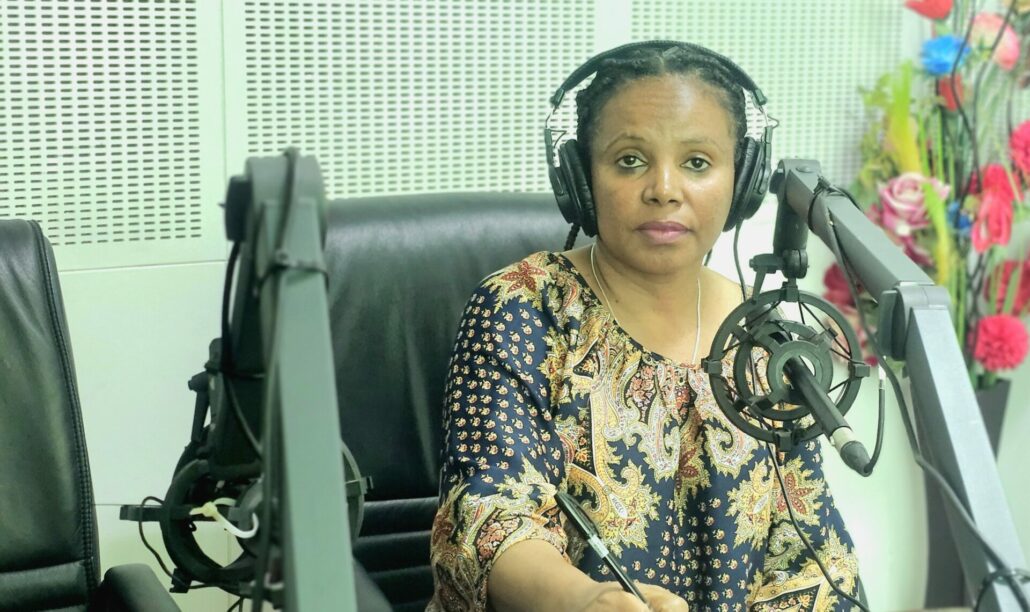Ethiopia: Radio encourages local communities to participate in land use planning
Simagegn Abraham, a radio journalist broadcasting for the Amhara Broadcasting Corporation (AMICO)
Based in the Ethiopian Amhara Regional State’s capital city of Bahir Dar, Simagegn Abraham is a radio journalist broadcasting for the Amhara Broadcasting Corporation (AMICO). She has been a radio show host on various topics for the past sixteen years. Recently, Simagegn hosted a radio program discussing participatory and integrated land use planning work in the Dera and Fagita Lakoma pilot districts in Amhara Region.
As rural populations grow, and land comes under pressure from various interests, it needs to be administered using transparent and evidence-based methods that local communities support and have a stake in. Participatory and Integrated Land Use Planning (PILUP) is one such method. Our project (PILUP II), implemented by AMBERO Consulting on behalf of the German Government, is implemented in three pilot regions of Ethiopia. In two of them (Amhara and Benishangul Gumuz regions) our team engaged with local media, with the purpose of raising awareness. The purpose of both interventions is to inform and encourage community participation in land use planning in their respective pilot districts.
Expanding towns and peri-urban areas often result in loss of prime arable land and loss of livelihoods without adequate compensation, even if smallholder farmers have legal tenure rights. Without adequate planning and control, natural forests, wetlands, and the ecosystems that safeguard the environment, prevent soil loss and land degradation are at risk and their rich biodiversity may disappear entirely. The German Government-supported Participatory and Integrated Land Use Planning (PILUP) project is designed to address this deficiency by delivering ‘best practice examples’ of land use plans that are multifunctional, multi-sectoral, and are prepared with the participation of their resident populations.
In PILUP, land use is evaluated in a holistic and integrated manner: economic growth, population expansion, and resource use take place in a balanced manner enabling sustainable long-term development but also protecting the environment. Empowerment of local communities to participate in informed decision-making about their future is a key focus in PILUP, especially seeking the involvement of women and vulnerable groups in formulating the plans.
In Amhara, rural populations are high, and dependent on arable production, livestock, and plantations for their economic livelihood. However, safeguarding food production also needs to consider the future health of the environment. Fagita Lakoma in West Gojam and Dera in South Gondar were selected as pilot districts, where effective planning is expected to bring better economic and environmental outcomes in the future.
In South Gondar, smallholder farming has extended into the once-forested rugged and mountainous terrain. This has resulted in soil loss, land degradation, poor water supply, and loss of livelihoods. In West Gojam, the land use change of fertile farmland to urban expansion and forest plantations are observed land use challenges.
After the PILUP project kick-off on 30 November 2022, AMICO was contacted to host a radio show about the purpose, and objectives of PILUP, especially citizen participation. The radio series by host Simagegn Abrahm was entitled ‘Limited Resource’ and targeted local communities in Fagita Lekoma and Dera. The radio show followed a ‘magazine format’, each running for 20 minutes, twice a week, and included 4 or 5 participants selected from local communities in the two districts. The citizens were joined by experts to discuss and debate key subjects of concern and relevance about land use. The format was designed to encourage and elicit as lively discussion as possible. Simagegn recalls:
“We had a wonderful time interacting with the audiences, especially individuals from the two districts who posed important questions and demanded answers from the specialists. The program engaged audiences because it was interactive, played traditional music at key points to show its local identity, and as a result got keen attention from listeners in the districts.”
The radio program covers land use planning topics including ‘The importance and meaning of integration’, ‘How local communities can participate’, and ‘the contributions of individual sectors’. The radio series also presented and discussed the human rights-based approach to land use planning and the participation of women and marginalized groups.
Simagegn asserts that the radio shows encouraged local communities to better understand and know the benefits of participation. “Local communities have expressed their interests, using their Indigenous knowledge to identify the natural resources in their district (forests, wildlife, crops, historical places, tourism opportunities). Local communities are concerned and aware that there is an urgent need to restore balance to soil, water, and the environment”. She adds:
“I believe the information generated, shows a level of indigenous knowledge about the environment among local communities that is higher than expected; this needs to be incorporated into the emerging plans.”
Participants in the broadcasts were selected to be diverse, and included the elderly, women, and those with disability, helping to make the content inclusive and meaningful for all. Simagegn described that the conversations and dialogues were extensive, fostering common understanding about integrated and participatory land use planning and minimizing potential misunderstandings.
Simagegn noted that the local communities received the broadcasts well and expressed her excitement to keep the momentum and discuss the PILUP project’s implementation follow-up stories later. For example, how are land use requests in the pilot districts treated and aligned with the plan?
Author: Mr. Hailu Wudineh Tsegaye, Awareness and Education Specialist for PILUP II




